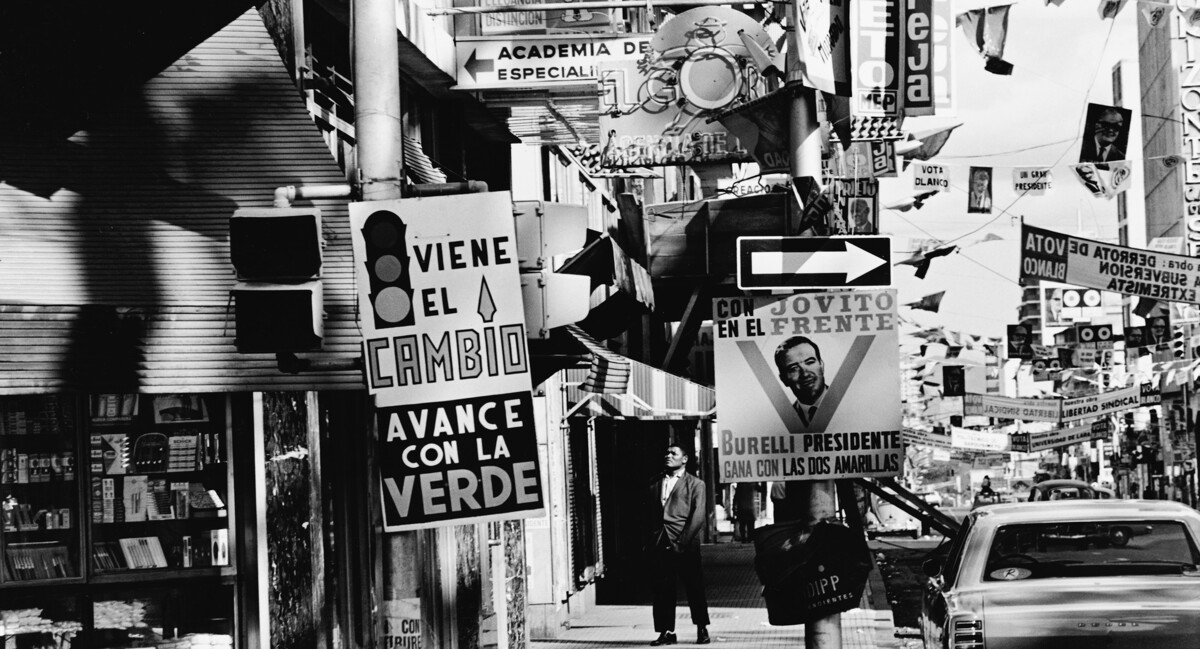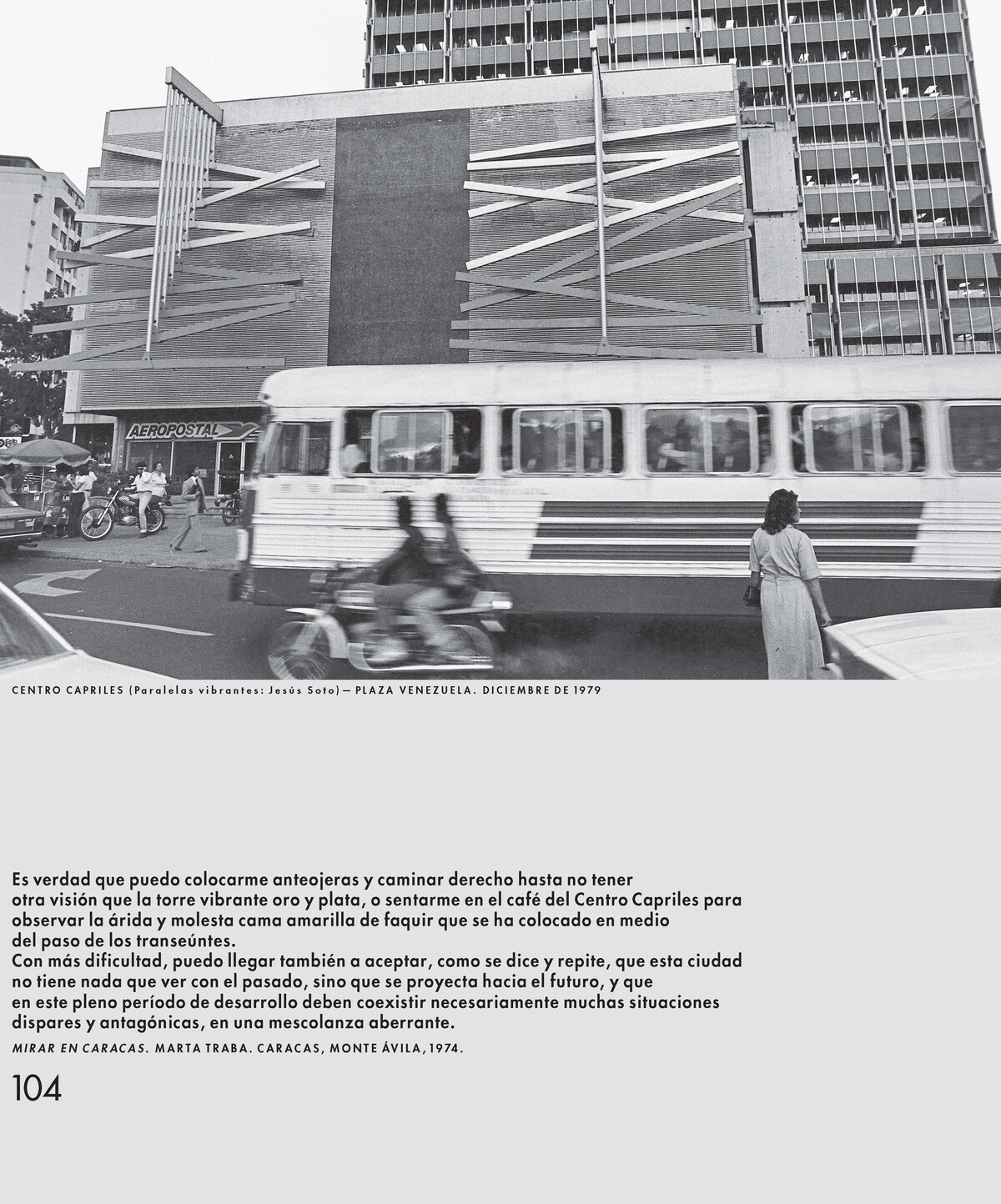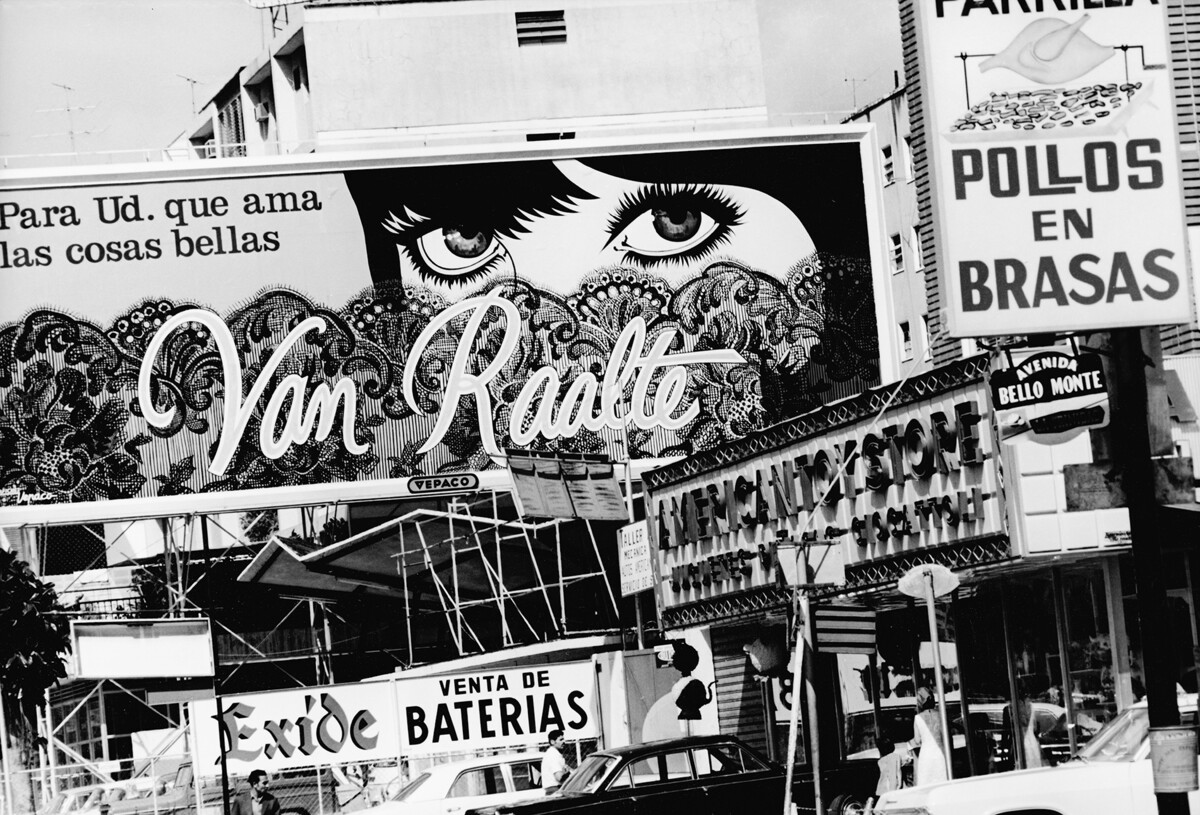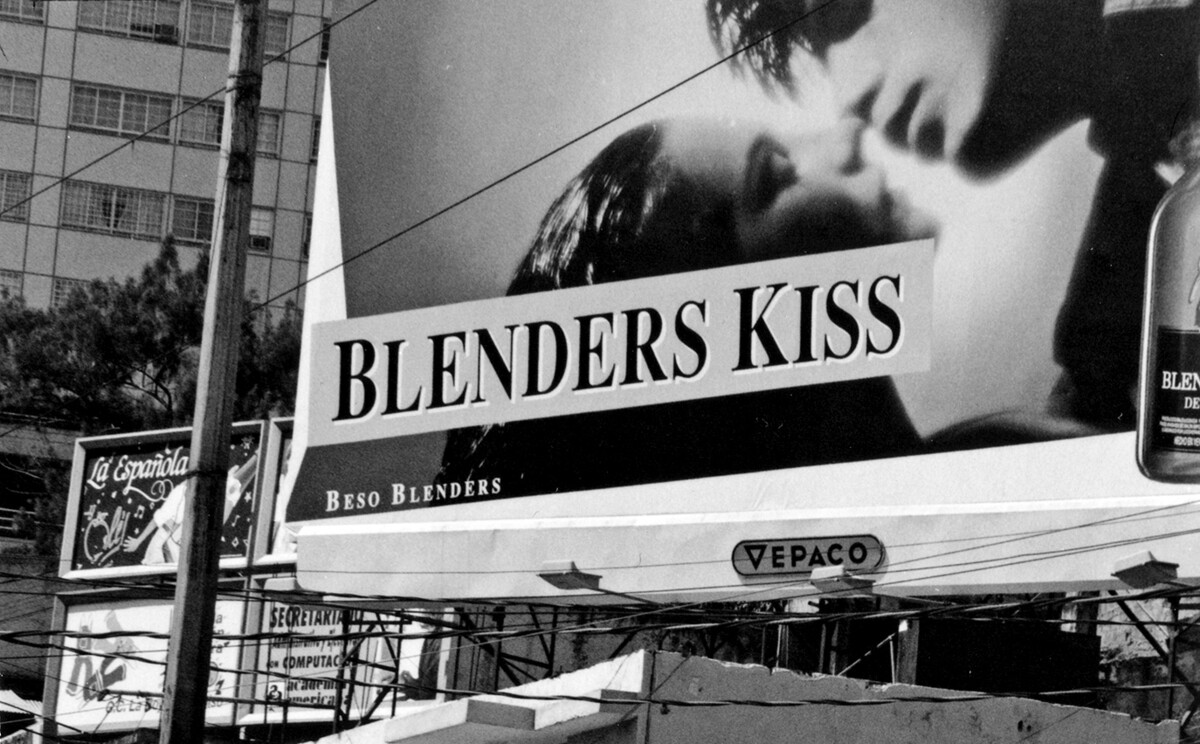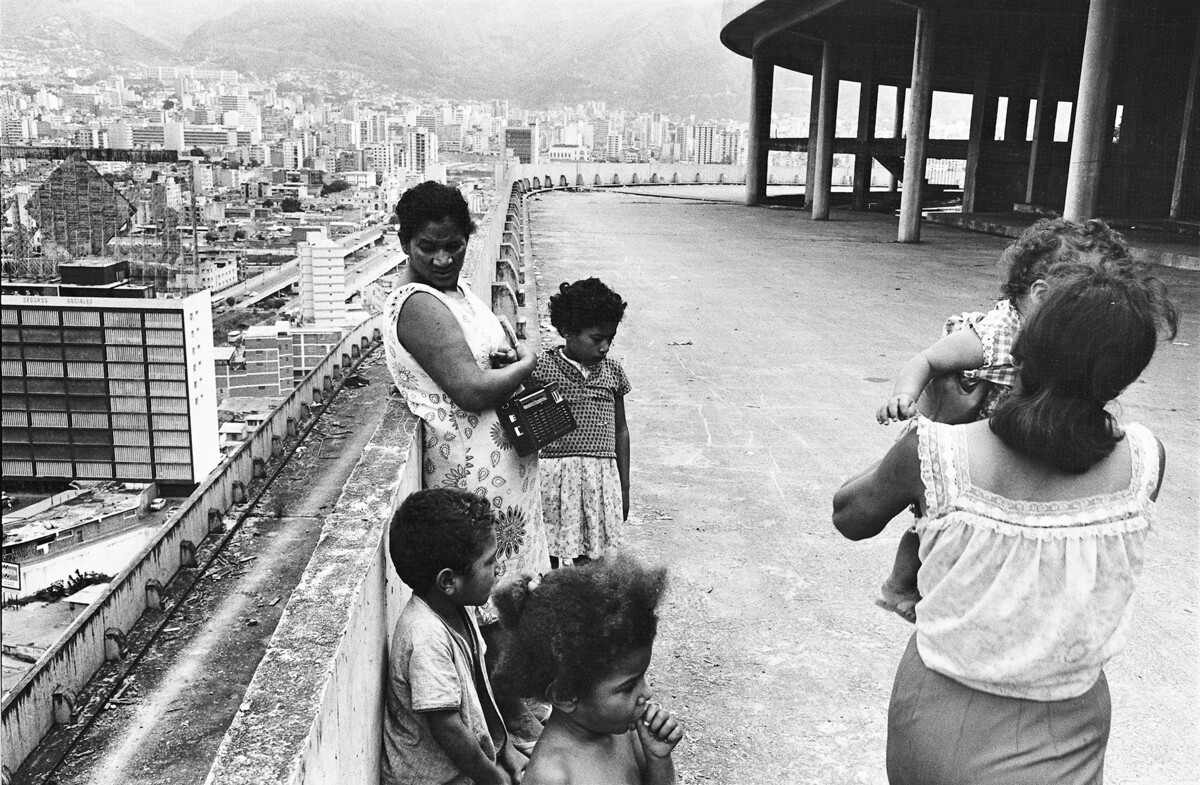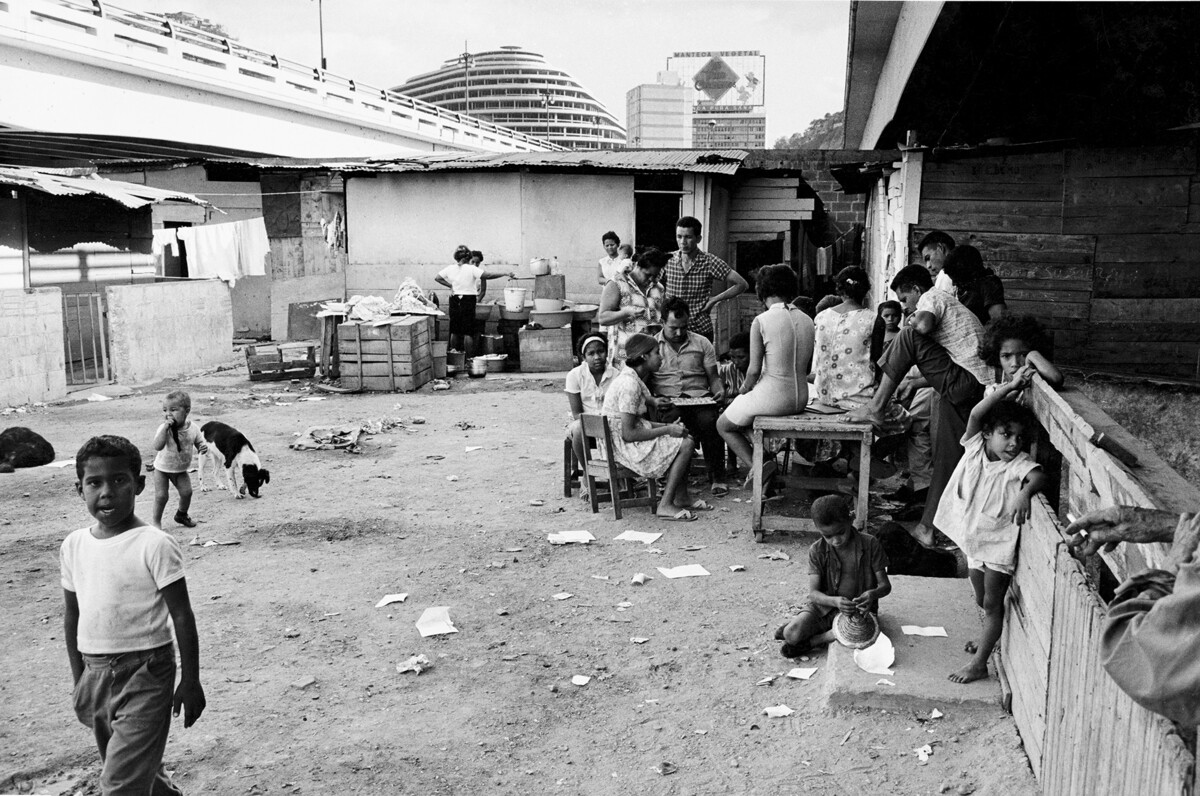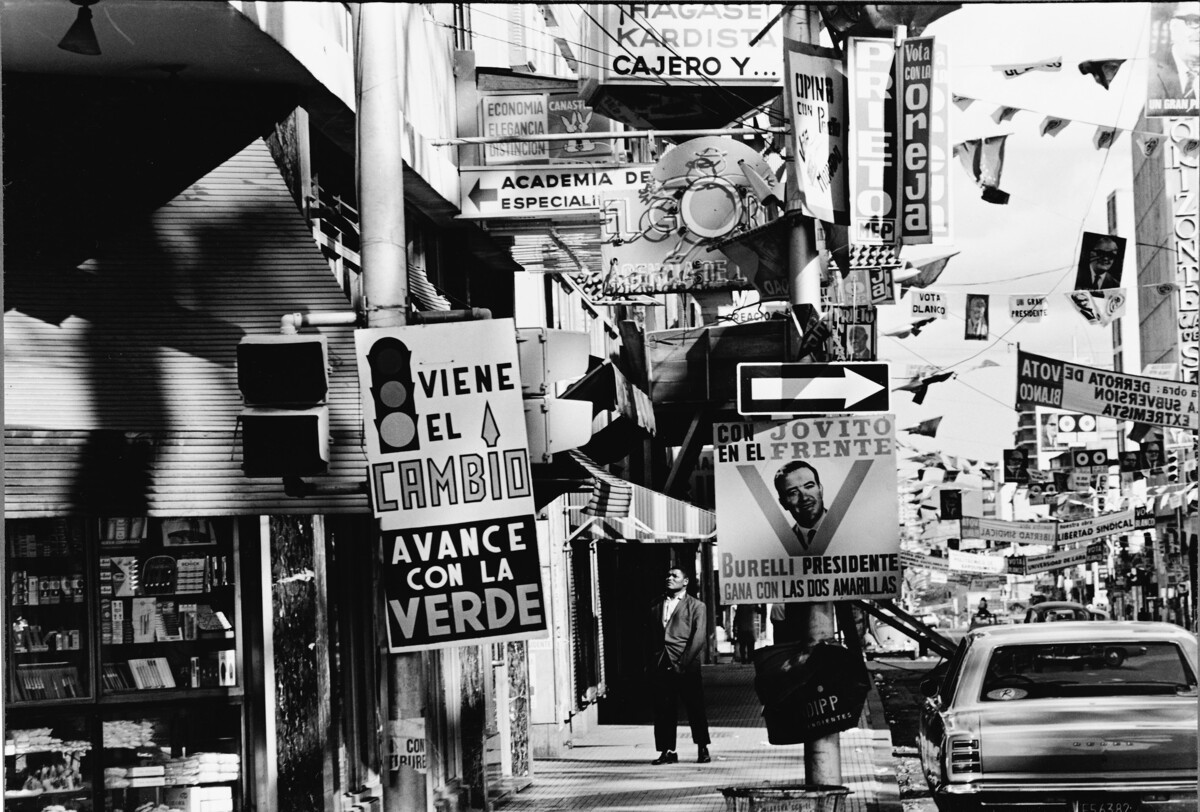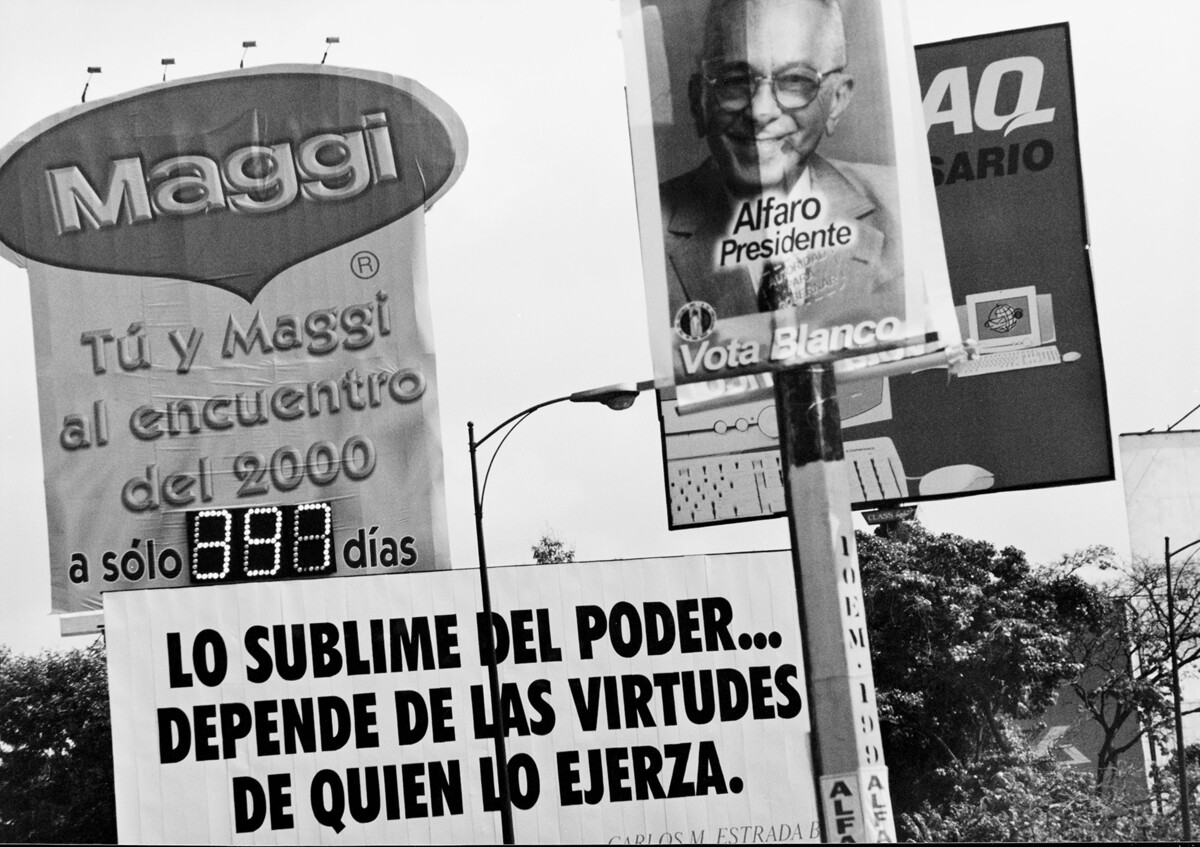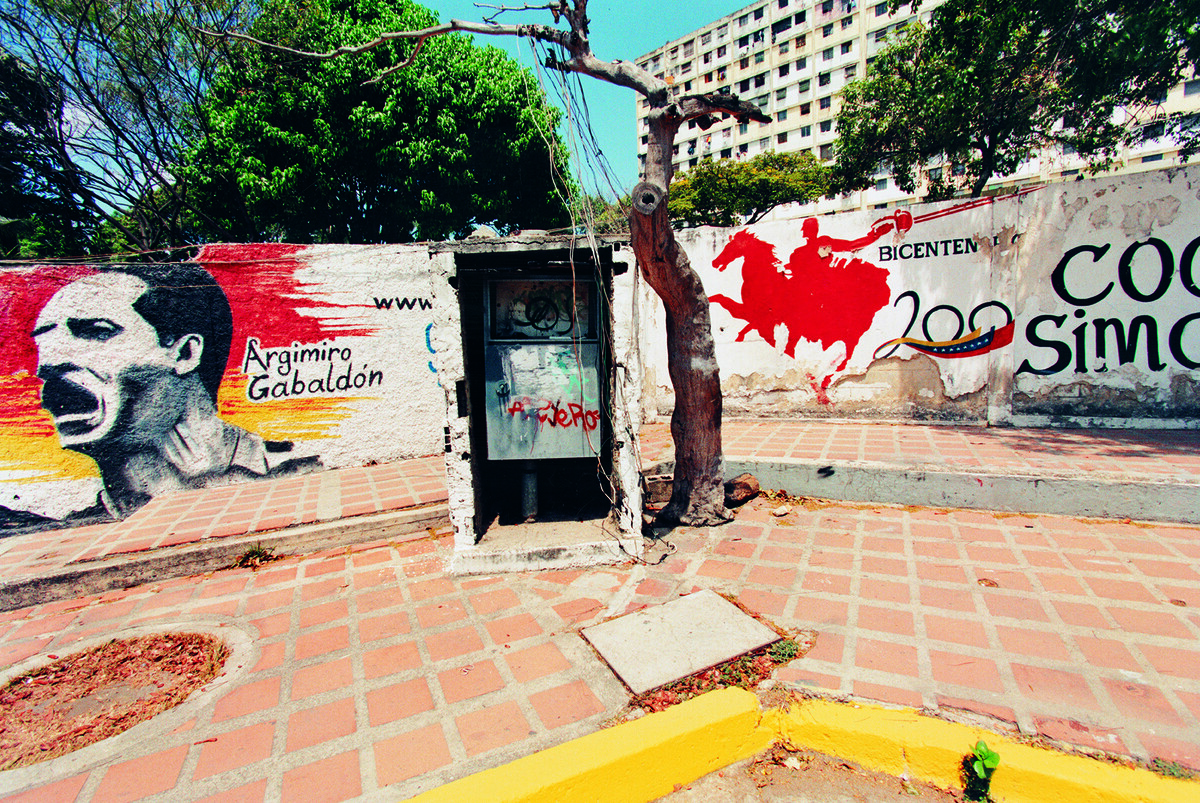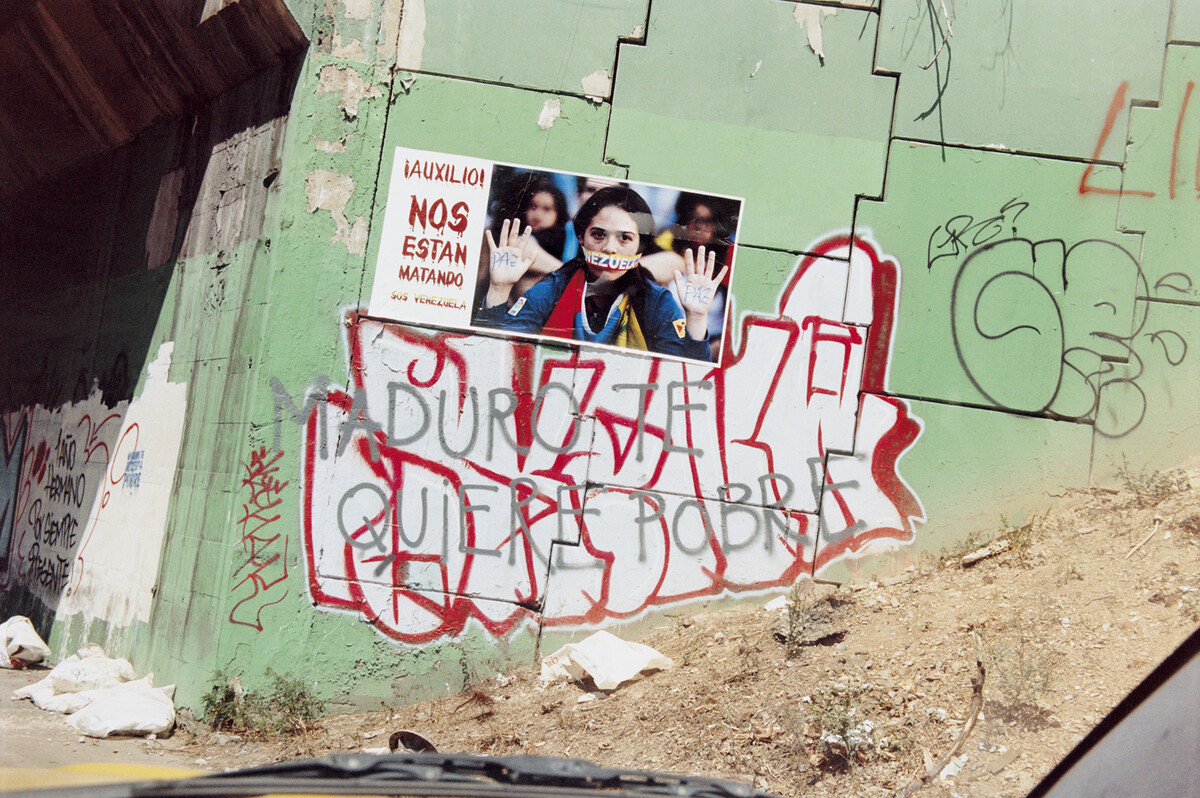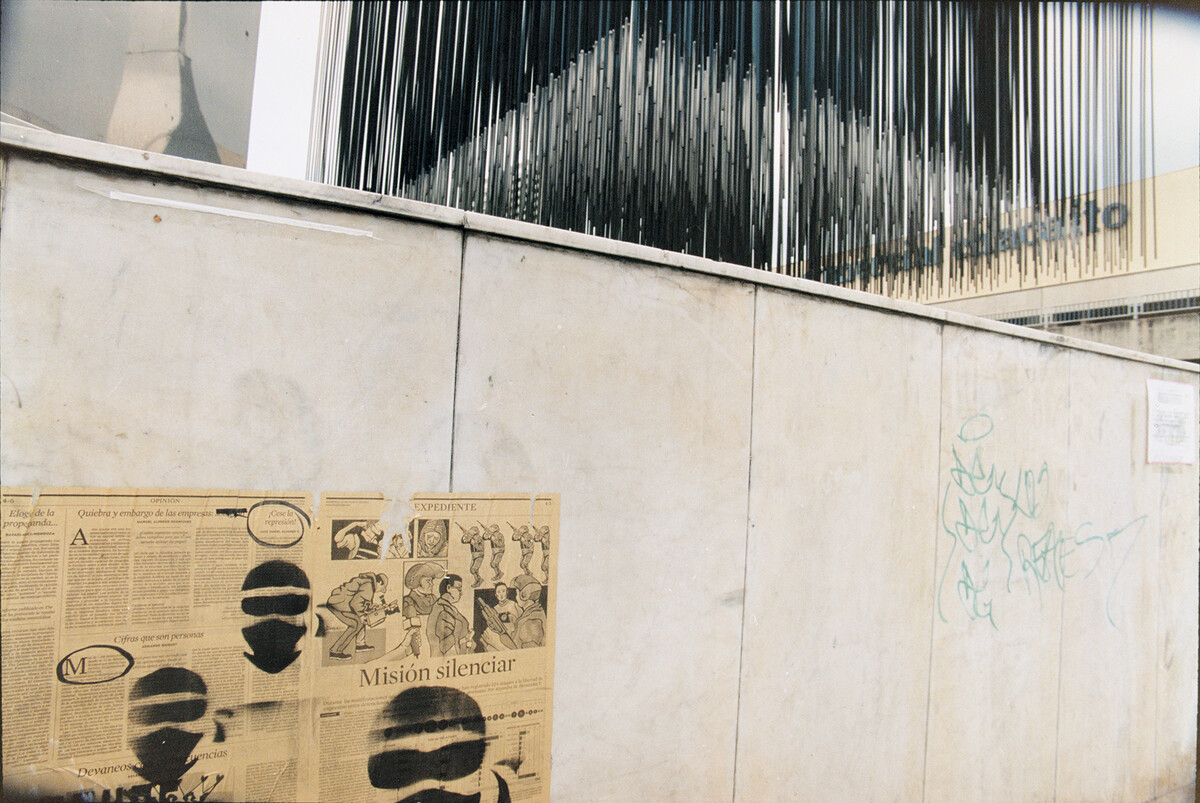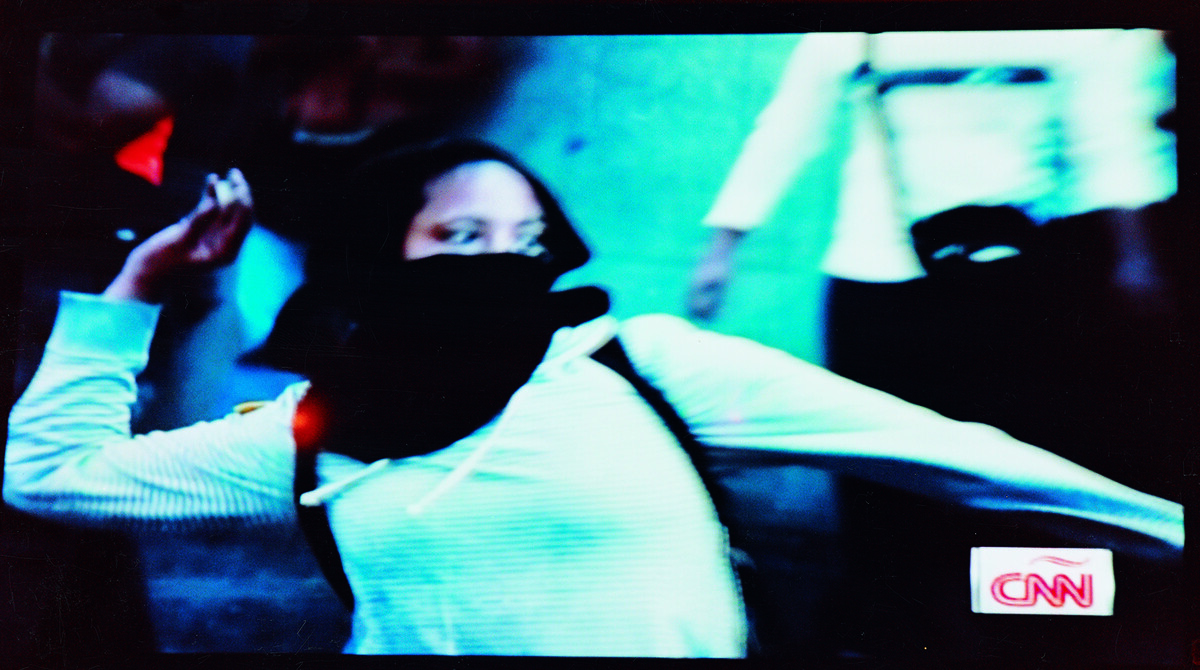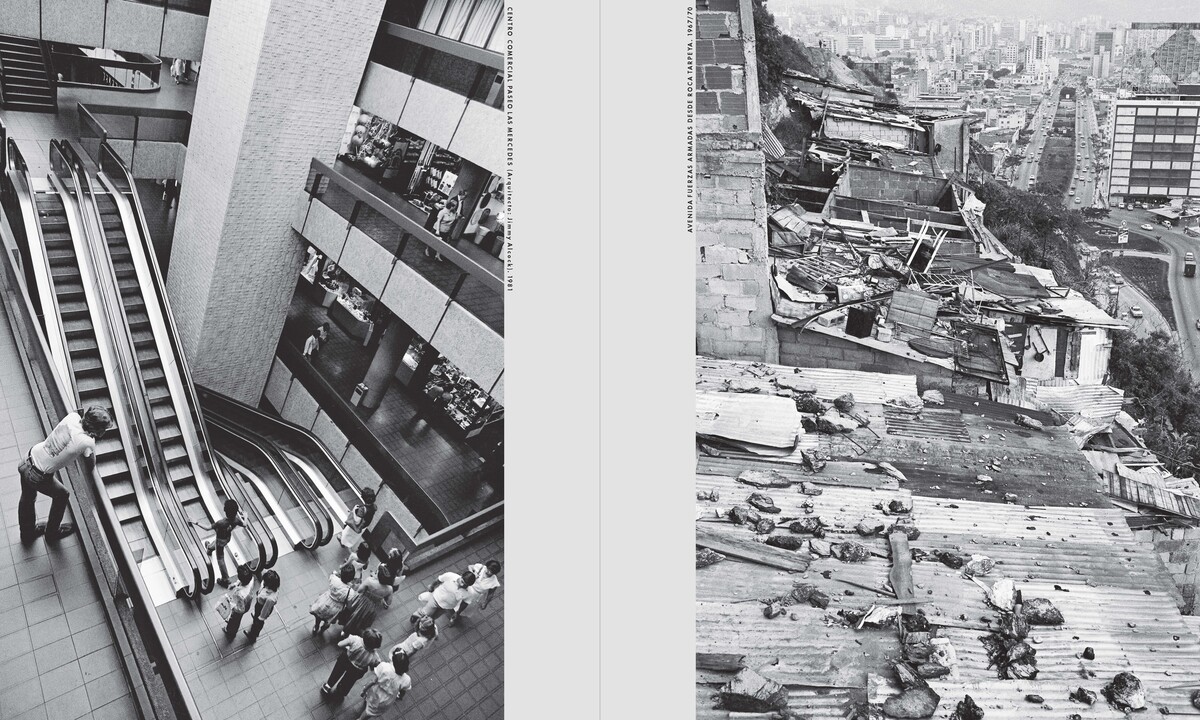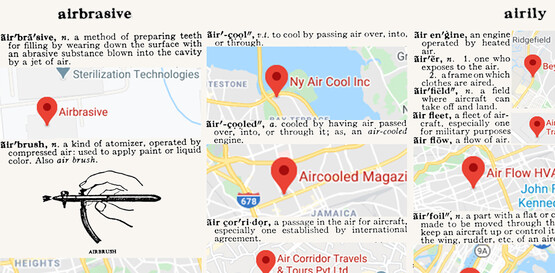Dreamworks of utopia: Paolo Gasparini’s ‘Karakarakas’
by Clara Maria Apostolatos • November 2023 • Journal article
Introduction
The Italian photographer Paolo Gasparini (b.1934), a resident of Caracas for almost seven decades, has been witness to the city in the processes of both its making and unmaking. It is a place of rapid urbanisation and transformation, but also of deep-seated social and economic inequalities. Published in 2014 by Editorial Mal de Ojo, the photobook Karakarakas: de la Cuarta a la Quinta FIG. 1 features 131 photographs that document the city from its mid-twentieth-century project of modernisation to Hugo Chávez’s implementation of socialism in the twenty-first-century.1 The images capture a variety of interactions between natural settings, built environments and human lives: helicopter views of towering edifices swarmed by the city’s sprawling barrios; merchants calling out for the attention of passing pedestrians; and celebratory religious processions alongside monumental military demonstrations.
Gathered together in the conceptual device of the photobook, these images articulate – whether within their own frame or in connection with other photographs – the mercurial and often contradictory situations in which the city has recently found itself. These juxtapositions are enriched by the formal parameters of the publication: the images in Karakarakas, which date from 1954 to 2014 and span the Quarta and Quinta Repúblicas (Fourth and Fifth Republics) of Venezuela, are not organised chronologically.2 Single-page photographs and double-page spreads evoke a more cinematic experience for the reader, as images of the two republics are not separated but rather flow in a rhythmic sequence. Every paradise has its contradictions, and those of Caracas lie in its pursuit of a visionary society while being hindered by the failures of its ambitious political and social revolutionary projects. This endeavour to embrace the future is at the heart of Caracas’s urban imaginary, heuristically defined here as the collective image, beliefs and perceptions that people hold about their city.
This article explores Caracas’s evolving urban visual narratives, specifically through the lens of Gasparini’s interrogating camera. Karakarakas purposefully and productively conflates the city’s physical structures with its values, aspirations and struggles, absorbed by an overarching ‘dreamwork’ of utopia and progress. It takes its title and framework from Lisa Blackmore’s Spectacular Modernity: Dictatorship, Space, and Visuality in Venezuela 1948–1958 (2017), which identifies mid-century Caracas as a ‘dreamwork of progress’.3 Drawing on Guy Debord’s Society of the Spectacle (1967), Blackmore argues that the ‘spectacular’ building campaign undertaken in Caracas during the 1950s constituted a certain mirage that obscured the sociopolitical realities of repression and dictatorship. Modernisation in Venezuela was not evenly distributed across the nation – neither geographically nor socially – and the state was able to temporarily redirect attention from the unequal aspects of an imported model of modernity by undertaking large-scale modern art and architecture projects. Consequently, Venezuela became a façade of hypermodernity that concealed the realities of dictatorship, severe poverty and social inequalities, while indirectly fostering a national vision that was not conceived endogenously but rather drawn from an external Western model.
Whereas Blackmore exclusively examined the much-celebrated building campaign undertaken during Marcos Pérez Jiménez’s military dictatorship (1952–58), this project shifts the focus to the photographic archive curated by Gasparini, a pivotal figure in the photographic documentation of mid-century Latin America. Rather than treating Gasparini’s photography as mere record, this analysis interprets it as a reflection of the more deceptive aspects of the Venezuelan modernist endeavour, as well as its more recent socialist project. The title of the article adopts Blackmore’s terminology, establishing a deliberate dialogue with her work, while positioning the argument within the realm of utopian ideals – especially pertinent when considering the expansive timeline of Karakarakas, which stretches all the way to 2014. This article contends that the notions of utopian vision and imagined states offer a rich lens for understanding the complexities embedded in the trajectory of Caracas’s urban aspirations, thus marking a departure from the linear and developmentalist narratives associated with ‘progress’. In doing so, it bridges the historical echoes of mid-century dreams to their enduring implications in contemporary perspectives on utopia.
In an effort to connect critical readings of the city with those of urban photography and the photobook more widely, this article considers three distinct yet connected registers: the urban and social elements of Caracas that are represented in the photos; Gasparini’s approaches towards photographing them; and the design and assimilation of the images into a photobook. Adhering to the division of Caracas into the Fourth and Fifth Republics, it investigates how Gasparini depicted the mythologies of progress that moulded and politicised the city during these two periods. It also examines how he dismantled the idealised narratives woven into these periods through the design and compilation of the photobook. The first section explores images of the Fourth Republic that reveal the complex relationship between the ideals of Modernism adopted in Venezuela and their material manifestation in the design of its capital. This is followed by an analysis of the images of the Fifth Republic, and display tactics used to build a cult of visionary leadership similar to that developed during the modernising project of the Fourth Republic, only this time reflecting a new ideological order employed in the service of a socialist dreamwork. Finally, it considers how the particular arrangement of images – their interactions with one another, their place in a sequence and their dialectical relationship with quoted text – and the book’s objecthood reveal ruptures in the dominant order of Venezuelan photographic representation.
The Fourth Republic
Gasparini’s images dating to the Fourth Republic span from 1954 – the year he moved to Venezuela – to 1998. During these five decades, the overarching urban and cultural focus was to modernise the city, opting for progressive capitalist modes of production that fostered economic freedom and reflected Western, particularly North American, lifestyle standards. This goal was pursued by different governments with their own distinctive strategies and agendas.4 Much has been written about how the landscape of Caracas was designed in the 1950s to foster an urban vision of the city’s economic and cultural potential as well as its global legitimacy.5 Caracas is home to exceptional architecture and art programmes. For example, the Ciudad Universitaria de Caracas, the principal campus of the Universidad Central de Venezuela, was the foremost synthesis of visual arts and architecture. Designed by the architect Carlos Raúl Villanueva, it seamlessly integrates sculptures, murals and landscaping – commissioned from such artists as Francisco Narváez (1905–82), Alejandro Otero (1921–90), and Oswaldo Vigas, and such international artists as Jean (Hans) Arp (1886–1966, Alexander Calder (1898–1976), Fernand Léger (1881–1955), and Victor Vasarely (1906–97) – within functional architecture. It was part of a larger programme in which state authorities promoted large-scale civil projects that became signature urban landmarks of mid-century modernism.
Geometric Abstraction and the state-sponsored Kinetic art movement were dominant presences in the urban fabric of Venezuelan cities well into the 1980s.6 Rigid geometric structures formed optical illusions to make them appear as though they were transforming, moving or vibrating. Kinetic artists aimed to develop a modern art with universal appeal that would suit the rapidly developing Venezuelan landscape. During their rise to prominence in the 1960s, Kinetic artists were commissioned by the Venezuelan state to align public art with its modernist ideals, which on the surface were seemingly apolitical in nature. In reality, however, these architecture and art programmes disguised the uneven qualities of the state’s modernising efforts.7
A photograph of Centro Capriles taken in 1979 FIG. 2 freezes a busy street in time. The graphic stripes on the side of the bus resemble the line arrangement of Soto’s Paralelas Vibrantes (Vibrating Parallels; 1969) on the Torre Capriles behind it. While the rest of the city is suspended in dynamic motion, the impression of movement in the Kinetic sculpture is revealed as merely an aesthetic ideal and illusion. The text printed below the photograph is taken from Marta Traba’s Mirar en Caracas (Looking at Caracas; 1974), which establishes a clear connection between the aesthetics and modernist ideals of Kinetic art with the identity of the city: ‘With more difficulty, I too can begin accepting, how people have said and repeated, that this city has nothing to do with the past, but rather projects itself towards the future’.8
The art historian Luis Pérez-Oramas argues that the Venezuelan state’s harnessing of these works in the service of modernisation can be ‘understood as a sort of abstract “muralism”, devoid of narrative yet able to convey, by means of the prodigal force of optical variation […] the spectral figure or the “Kinetic illusion” of Venezuelan modernity’.9 This style of Venezuelan muralism, in tandem with modernist architecture, emerged as the ultimate expression of the country’s vision of the future, ‘one of bringing a form of European culture to a tropical nation’.10 Yet the Kinetic urban art programme simultaneously created an illusion of progress, by making Venezuela appear to have the same pattern of aesthetic and industrial innovations as Europe and North America.11
Kinetic art eventually came to be associated with an exclusively capitalist modernity. Gasparini’s images of lavishly stocked storefronts, vast mall interiors and seemingly endless rows of brand-new cars symbolise the consumption-driven culture that accompanied modernisation and celebrated the country’s growing wealth.12 In a 1967/68 photograph FIG. 3, a pair of large, flirtatious eyes on a billboard captivate the viewer: an example of ‘our love for beautiful things’, as the advertisement proclaims. Another image from the Santa Fe Sur neighbourhood FIG. 4 shows an advert for the alcohol brand Blenders Kiss. The combination of indulgent imagery – of sex and alcohol – brings to mind the potent allure of consumerist culture and the mechanisms through which display technologies seduce those who engage with them. Additionally, the bilingual billboard underscores the assimilation of the English language and other aspects of Western culture within the city. This world of excess is also conveyed in Gasparini’s images of foreign car models in the automobile showcase of 1967, and in photographs of crowded, busy shopping centres. Karakarakas also includes images of street vendors selling plastic novelties, glasses and street food. These coded images of consumerism – on both small and large scales – make apparent how the notions of modernity promoted by the state were in fact instilling immense social and economic divisions among Venezuela’s population.
The Helicoide de la Roca Tarpeya: Centro Comercial y Exposición de Industrias (Helicoide of the Tarpeian Rock: Shopping Centre and Showcase of Industry), a modern mall turned into a panoptical prison, is arguably the quintessential ruin of this project.13 The architects Pedro Neuberger, Dirk Bornhorst and Jorge Romero Gutiérrez designed the Helicoide as a state-of-the-art shopping centre and exhibition site for national industrial products. Covering an area of 101,940 square metres on the western section of the Roca Tarpeya hill, the double helix structure’s first construction phase was completed between 1956 and 1961.14 The building, which was encircled by two miles of vehicular ramps meant to facilitate easy access to its retail businesses, embodies two key aspects of the ‘American way of life’: highway transportation and shopping centres.15 Despite gaining an international reputation – when photographs of its model were published worldwide and became a key part of the exhibition Roads, held at the Museum of Modern Art, New York, in 1961 – the Helicoide experienced a series of political and financial disruptions and construction was halted.16 In 1975 the Venezuelan government took over the Helicoide, and since 1985 it has served as a centre for police training and political imprisonment.
Taken from the ramp of the building FIG. 5, a photograph showcases a family in the foreground, with the valley and the city extending into the horizon behind them. The Helicoide symbolises a form of capitalist aspiration through its very architectural blueprint: a spiral ascending towards a consumer heaven. Nevertheless, as Gasparini’s photograph implies, this Babelesque structure relegates the majority of Caracas’s population to the ground, effectively excluding them from the lofty aspirations it symbolises. A helicopter view of the Helicoide FIG. 6 and its surrounding barrios, which in the last six decades have expanded to envelop the structure, allude to the gross inequity of this capitalist project and one of the major negative repercussions of a period of rapid modernisation: a disproportionate commercial ambition that cannot meet the fundamental needs of the surrounding communities. A third photo of the Helicoide FIG. 7, taken from underneath a nearby highway, further illustrates the theme of social disparity. Here, unlike idealised depictions of urban developments, Gasparini deliberately unveils the underside of modernity, shedding light on what is conventionally disregarded. Although the upwards angle should endow the Helicoide with a sense of monumentality, it paradoxically appears diminished. This perspective redirects attention away from the Helicoide itself and towards the adjacent social circumstances, underscoring the stark reality of existence for those living in its shadow.
The photographs examined thus far have primarily focused on the vast urban structures and architecture programmes that correspond to official projects aimed at modernising the city. It is in these images that Gasparini points to the failures and exclusionary aspects of such endeavours. They demonstrate how Venezuela became a hypermodern façade that masked extreme poverty and social divisions, while continuing to present itself as a modernist utopia to the world.17 Urban barrios – like Petare, one of the largest slums in South America – have traditionally been discounted as a legitimate component of Caracas. Although these informal homes cover seventy per cent of the city, official maps have traditionally depicted them as green spaces or unmarked areas.18 Gasparini captured these neighbourhoods FIG. 8 and their interiors, offering a counter-narrative to the formal imaginary of the city.
In images featuring campaign posters and political rallies, the pictured propagandistic text doubles as symbolic codes for the promises and aspirations of a utopian construction of Caracas. Gasparini’s 1968 photograph of Avenida Urdaneta FIG. 9 features an intricate network of traffic indicators, political banners and flags, creating a chaotic entanglement of signage. In the centre foreground, a poster with a green-lit traffic light graphic design proclaims ‘Viene el cambio’ (‘The change is coming’). It hangs next to an unlit traffic light, either caught between signals or in disrepair. The juxtaposition of posters endorsing various candidates and political parties coupled with traffic signs with arrows pointing in different directions contributes to a cacophonous interweaving of spatial and political indicators, inducing a visual delirium. Through their allusions to voting processes, images such as this foreground the citizens’ democratic consciousness and political agency. This idea is also present in photographs of public demonstrations and voting ballots paired with Article 44 of the constitution, ‘La libertad personal es inviolable’ (‘Personal freedom is inviolable’). In contrast, an image of a graffito that reads ‘Votar para que?’ (‘Why vote?’ or ‘Vote for what?’) embodies a disillusionment with the democratic and electoral system.
A photograph of the Autopista Francisco Fajardo FIG. 10 is one of the few from the late 1990s, and it acts as something of a visual transition between the Fourth and Fifth Republics. Its invocation of the turn of the millennium operates as an important sequential anchor in the book. Taken in 1998, in the same year that Chávez won the presidential election, the photograph references the transition of power that would mark the start of the Fifth Republic. To the far left, a large advertisement for Maggi food products counts the days until the start of the year 2000. While the billboard celebrates the march towards a new millennium, the illegible numerical countdown symbolically suspends time. The Luis Alfaro Ucero presidential campaign and the billboard advertisement for a new computer further imbricate the image with idealisations of the future. The street light and large billboard in the foreground make clear that the location is a street or avenue, but Gasparini’s framing removes the road – the emblematic path forwards. In bold font, the billboard reads ‘Lo sublime del poder […] depende de las virtudes de quien lo ejerza’ (‘The sublime of power [...] depends on the virtue of those who wield the power’). Yet in the reality of Caracas, this logic is inverted: those who have power too often abuse it.
The Fifth Republic
Chávez renamed Venezuela the República Bolivariana de Venezuela in 1999, marking the start of the Fifth Republic. Out of the 131 images included in Karakarakas, only sixteen were taken in the twenty-first century, of which all but one were taken during the year of Chávez’s death in March 2013. Documenting the demise of the political figure who founded and led the Fifth Republic party, they are imbued with a historical and contextual specificity and act as a sort of postscript. Unlike the images of the Fourth Republic, which were sourced from Gasparini’s personal archive, the Fifth Republic photographs were taken specifically for the photobook. This establishes an intentional bridge between the past and present, anchoring the utopian concepts of the Fourth Republic within a new century, also marked by visionary aspirations and their concurrent challenges.
The most significant aesthetic difference between Gasparini’s Fourth and Fifth Republic images is in the adoption of colour photography. In certain images, the use of colour vividly captures the pervasive red hue the city had taken on during a period of widespread propaganda efforts. Such is the case in a 2013 photograph FIG. 11 of painted walls topped with barbed wire, from behind which looms a state-sponsored portrait of Comandante Chávez. He salutes the viewer and guards over the scene. Gasparini’s compositional arrangement, constructed with a similar sense of pervasiveness or omnipotence, suggests the ubiquitous watchful eye of the state that assures, following Michel Foucault’s theory of social control, the automatic functioning of power.19
Taken in March 2013, a photograph of the district Parroquia 23 de Enero FIG. 12 is laterally bisected by another large wall with a state-sponsored mural. This propagandistic strategy falls into a Leftist tradition that involves the politicisation of urban space, which is deeply rooted in a broader Latin American context. Examples include the politically charged Mexican muralism that emerged in the aftermath of the Mexican Revolution (1910–20). Initially funded by the government and prominently displayed in civic buildings, these large public works, not dissimilar to Chávez’s revolutionary mural campaign, aimed to shape a new national character. The heavily chipped mural in Gasparini’s photograph features the revolutionary figure Argimiro Gabaldón and the logo for the Bicentenario (200th anniversary of independence), two emblems of the moral and spiritual character of the Bolivarian Revolution.
The Bicentenario imagery reappears in another weathered mural that shows three children eating against the backdrop of the Venezuelan flag FIG. 13, which had been updated by Chávez in 2006. From 1863 the flag featured an arc of white stars representing the seven provinces that signed the Independence Act of 5th July 1811; in 2006 Chávez added an eighth star – called the ‘Bolivarian star’ – in honour of Simón Bolívar as a symbol of the province of Guayana. He also changed the direction of the horse in the coat of arms, which appears in the official flag’s upper-left corner, so that it is galloping towards the left, symbolically changing the course of the country towards socialism. The mural also references the consumption of food, which takes on a somber edge in the context of Venezuela’s food shortage of 2013. In the background, a tall bank building looms over the scene; its monumental presence is amplified by the low vantage point, and the framing of the buildings leads the viewer’s gaze towards the imposing architectural structures beyond. The perpendicular lines of the buildings intersect, crossing over both the financial institution that stockpiles reserves of wealth and the populist mural that promotes the socialist distribution of goods.
Gasparini’s images of the Fifth Republic highlight display tactics for building a cult of visionary leadership akin to those developed during the modernising project of the Fourth Republic. Rather than promoting a notion of progress tied to modernity and its associated myths, the Chavista government pursued a socialist dreamwork. Chávez headed the Bolivarian Revolution – which references the continental liberation effort led by Bolívar in the early nineteenth century – to achieve popular empowerment and political transformation in the twenty-first century. As part of his strategy to reshape Venezuelan society, Chávez refounded the republic through a constituent assembly and a new constitution. The utopian aspirations of this socialist revolution sought to heal the ills of the Fourth Republic and embrace a more equitable and just democracy. However, the populist revolution achieved more symbolic success than effective social change.
To legitimise the Bolivarian Revolution, Chávez relied on a historical genealogy that positioned himself as the redeemer of the poor, paralleling the role of Bolívar, El Libertador. Symbols of socialism, anti-capitalism and public participation became the basis of a new political and social imaginary. In this sense, the Fifth Republic aimed for a national authenticity in the imagining of the city and of the country that was not shaped according to Western standards. This new form of national identification looked to and employed the more distant past – that is, the founding movement and principles of Venezuelan independence from Spain. Critics of the movement argue that the Bolivarian Revolution’s emancipatory attitudes and aesthetics masked Chávez’s personal ambitions, concealing his increasingly authoritarian style of government.20 This resonates with the tactics of display of the Fourth Republic, which gave Venezuela the appearance of a thriving modernity that in reality was concealing severe poverty and social inequalities.
Some of the twenty-first-century photographs feature informally inscribed words and images in the city’s built environment. One of a graffitied cement structure FIG. 14, most likely the underside of the Francisco de Miranda highway, shows a banner of gagged woman, who is framed by text that reads ‘¡Auxilio! Nos estan matando’ (‘Help! They’re killing us’), ‘Maduro te quiere pobre’ (‘Maduro wants you poor’), and the briefly popular hashtag #SOSVenezuela. In this photograph Gasparini introduces the input of city-dwellers and their voices into the built environment. In another photograph FIG. 15, guerilla-like iconography related to military tactics of silencing is plastered on a white wall. Behind it, a colossal Kinetic sculpture consisting of sharp black lines descends from above. A revolutionary emblem for political inertia in the present sits in stark contrast to an object from an art movement that emphasised motion (both real and illusory) during Venezuela’s golden age of modernity. These informal civic expressions result from the inhabitants’ desires to articulate their own political agency. They are acts of re-socialising public space and restoring media, which over time had become more regulated and censored by the Chavista government. As such, they serve as a vital and popular expression of the urban imaginaries of Caracas.
The final two images in Karakarakas focus on a television screen as it streams CNN en Español’s coverage of the 2013 protests in Caracas FIG. 16 FIG. 17. Characterised by a lack of focus and heightened saturation, these images culminate in a hazy photograph of armed forces charging towards civilians. As though crystalised in amber, the scene is bathed in mesmerising red and yellow. This crimson hue, embraced by the Leftist party to symbolise a new socially equitable society, now washes over an image of political resistance. It also alludes to the violence and bloodshed amid a period of intensified public protests. A major news outlet in the region, CNN en Español presented Venezuela and its capital to the rest of the world through the dual lenses of the television screen and the figurative scaffolding of precarity, danger and undemocratic power transfers. If the images from the Fourth Republic evidenced the flaws of the country’s modernisation project, these concluding photographs illustrate the failure of another fabricated utopian dreamwork.
The photobook
Urban designs serve not only as a physical manifestation of a regime but also as an ideological one. Karakarakas illustrates how twentieth-century modernist imaginaries bear a symbolic visionary lineage that is perpetuated into the twenty-first century. These images were selected and sequenced by Gasparini; the book was designed by the graphic designer Ricardo Báez with French fold binding and cardboard covers; and it was printed by Editorial Ex Libris in Caracas. A text by the novelist Victoria de Stefano – divided into two sections and interspersed with photographs – speaks to the urbanisation of Caracas; it is imbued with affective feeling that contrasts with the hard and dry transcriptions of articles from the 1999 constitution. On the back cover a text by the photographic historian Sagrario Berti, who was also the book’s editorial coordinator, connects Gasparini’s archival exploration with the construction of personal and collective memory, enabling an autobiographical discourse of the city, and a statement by Gasparini expresses the intentional departure from the conventional ‘coffee-table book’ format. The quotes from the constitution and an assortment of remarks by Latin American intellectuals, from Venezuela and elsewhere in the continent, are irregularly spread across the book. The graphic, material and textual elements interact with Gasparini’s photographic archive. Individual photographs abandon their character as standalone works, instead becoming integral components of a sequential composition with rhetorical resonance.21 How, then, does the unique formatting and objecthood of Karakarakas turn the image from a document of photographic capture into an article of emotive and rhetorical expression?
Throughout the book, various facets of Caracas exist in tension. For instance, fast-moving cars in urban centres contrast with scenes of congested traffic swarms, symptomatic of decades of neglected transportation infrastructure. Masses occupying the streets in protest speak to a civilian political agency that is overtly constrained in other photographs, as crowds are surveilled by the military and police. Other contrasts are subtly alluded to in the pairing of images in double-page spreads. For instance, the aforementioned photograph of a Chávez mural is printed next to a 1979 image of the erecting of the Monumento Colón en el Golfo Triste FIG. 18. This arrangement places the static, commemorative sculpture of Christopher Columbus against the vibrant revolutionary imagery found on public murals. As noted in the caption, the statue was removed in 2004 during El Día de la Resistencia Indígena (Day of Indigenous Resistance), which was formally known as Columbus Day and renamed in 2002 to honour Venezuelan Indigenous culture and anti-Spanish resistance. The text printed below the photograph speaks to the idealisation and possibility of liberation processes. Collectively, these elements prompt a discussion about the creation and conditioning of national symbols – specifically, how emblems can promote an identification with the nation as much as the ideologies embedded in them. This discussion underscores that emblems, and their contestation, can be instrumentalised to shape collective identities.
Whereas at points thematically resonant images are paired, at others the layout of the photobook employs a distinctive visual mirroring technique, whereby images are positioned as reflections of one another – both in their formal composition and symbolic implications. In one spread FIG. 19, the diagonal pull of mall escalators is echoed in the slanting roofs of makeshift homes; the images are formal inversions of each other that underscore the paradox of disparate realities in Caracas. In another, the Ciudad Universitaria de Caracas is photographed in stark black-and-white contrast with two figures walking along the Plaza Cubierta FIG. 20, casting long shadows alongside them. This image, with its embedded connotations of the promise of education and the bright cultural hub that the architecture promised, is contrasted by a funerary procession on a wide highway adjacent to the site of the principal action.
Gasparini’s images, like the dialectical image developed by Walter Benjamin, capture a moment of contradiction where opposing forces or ideas are present.22 The dialectical image, in its moment of tension (when present and past come together ‘in a flash with the now to form a constellation’), has the potential to disrupt the dominant historical narrative and reveal the underlying social and political forces at work.23 Similar to Benjamin’s figures of critical constellations, the thematic arrangement of photographs in Karakarakas disrupts historical continuity, allowing images to be juxtaposed in the moment of their confrontation.24 Through interactions between images and their particular places in a sequence, Karakarakas invites us to shift our attention between past and present, revealing how memories intertwine revelation, elaboration and permanent resignification. Thinking in constellations allows for the kind of interference that can provide new possibilities for understanding. In this regard, the photobook assumes the character of a rhetorical device through which Gasparini imparts significance beyond the scope of the visual content: where the images capture the cultural orientations of ostensibly different periods, the design of Karakarakas points to the mythology of their differentiation.
The photobook’s subtitle, ‘from the Fourth to the Fifth’, suggests a progression from one period to the next, but the two periods are not so clearly delineated, differentiated or sequenced in the photobook. The title Karakarakas, which phonetically resembles ‘facing Caracas’ in Spanish and ‘dear Caracas’ in Italian, is written with Ks instead of Cs in reference to Kodak films. It also recalls Franz Kafka and his allegorical, surreal style of writing about the struggles of individuals against incomprehensible systems. Gasparini writes, ‘the Spanish word “cara”, with a C or a K, always relates to a face, a façade or front, also to a city that has two faces’.25 This wordplay treats the city both as a portrait and a letter, effectively collapsing the barrier between the visual and written mediums, much akin to the photobook format. The unstructured serialisation of images and photographic content of illogical social orders mirror Kafka’s sardonic manner of writing about absurd social situations. The title is further distorted into an even more repetitive sound on the book’s spine, where it is elongated to ‘Karakarakarakarakas’. This tongue-twisting quality encapsulates the complex interplay between language and representation, hinting at the intricate exchange between political rhetoric, cultural shifts and historical distortions that shape our understanding of a place.
Notions of fabulation resonate throughout various facets of the photobook. As a mode of creative expression grounded in photographic capture, the photobook plays with boundaries between objectivity and subjectivity, reality and idealisation. Karakarakas brings together diverse ways of representing and understanding the city. These encompass nationalist symbols, place names, written descriptions, constitutional laws and iconic landmarks. Ultimately, these components find dissemination through printed media. Photography has played a significant role in shaping both the city’s urban imaginary and the global perception of Venezuela as a nation. In Fotografía impresa en Venezuela (2019) Berti delineates two primary categories of printed photography. The first comprises state-financed publications, often taking the form of coffee-table books, which present glossy photographic images in a lavish design. They have the potential to construct a myth or lore surrounding a particular place, influencing people’s perceptions and expectations of it.26 The second category encompasses authored or self-published photography books, which includes Karakarakas. In such books, photographs do not serve ‘an ornamental or illustration role, rather they are used in sequences with a clear authorial intent to construct a visual narrative’ that is often more political, poetic, or dissident in character and effect.27
Karakarakas stands as a monumental printed volume, weighing 1.7 kilograms and measuring 30 by 25 by 3 centimetres when closed. The images are printed in a large format, lending the book a physical presence that falls somewhere between an encyclopaedia, an album and a monograph. In his work Art and Agency: An Anthropological Theory (1997), the anthropologist Alfred Gell suggests that art objects can be considered as agents, akin to persons, within an anthropological framework. An art object does not possess inherent agency; instead, it exerts its influence within a social context through interactions with its subject.28 This perspective on the nature of art objects encourages us to view them not solely through their symbolic meanings but also as material entities that elicit specific responses, inferences or interpretations.
Although Karakarakas shares some characteristics with the coffee-table book in terms of object agency and motivated response, there lies a dissonance between its initial impression and the actual experience of engaging with it. The book’s photographic and textual content, along with its graphic design, disrupt the conventional leisurely leafing through a large picture volume. Images are strategically paired through dialectical procedures, challenging a passive reading of the photobook’s photographic contents. Karakarakas subverts the ostensibly apolitical and purely aesthetic expectations associated with the coffee-table book. Moreover, it defies expectations of conventional photographic surveys of places, presenting an anti-canonical representation of the city that ultimately challenges preconceptions imposed by its objecthood. With its constellational features, Karakarakas offers a critical auto-narrative of the city’s urban history and character, where the myths of utopia and progress of each period overlap, dissolving the alleged antithetical symbolic distinctions between these epochs. Through the artist’s authorial discourse, the reader gains access to a new tale of the city’s imaginary character, bound by allegorical and mythic elements in its collective identity.
Conclusion
Utopias typically remain unattainable ideals, but they can serve as a guiding vision or goal that inspires collective efforts to achieve a better society. In some cases, however, attempts to implement utopian ideas have resulted in unintended consequences or even dystopian outcomes. This paradoxical fate is explored by Gasparini, who presents Caracas as part of a dreamwork of social progress and its failures. Karakarakas mirrors two opposing ideologies that failed to deliver substantive improvements to the city’s social structure despite repeated claims of economic and social reform. Urbanism schemes and place-branding reveal the varying forms of utopianism over sixty years: the second half of the twentieth century saw Caracas become an arena to project an idea of progress that was tied to modernity and its mythology, while the twenty-first century is marked by a drive towards revolutionary origins and a socialist future.
The administrations of both the Fourth and Fifth Republics were very efficient at the symbolic level. Between 1950 and 1975, Caracas underwent a profound transformation through extensive urbanisation that significantly altered the city’s landscape. The introduction of Kinetic public sculptures, universities, highways and malls laid the foundation for a new urban imaginary for Caracas, promoting a redefinition of collective identity in alignment with the values of modernity and economic neoliberalism. During his presidency, Chávez sought to establish a new visual language reflective of his government’s ideological values, a tactic that extended beyond physical infrastructure to include alterations to such national symbols as the flag, coat of arms, key landmarks and even the country name. This manipulation created the semblance of change, signaling a departure from the previous regime and its symbols, which Chávez associated with corruption, elitism and inequality. However, Gasparini’s photos subvert the Fifth Republic’s revolutionary disassociation from its preceding period, with all its failed ambitions. His lens exposes the illusion of a clean break, revealing the continuity of unfulfilled aspirations.
As a photobook where images are woven into a narrative, Karakarakas reveals a Gattopardian condition: a political strategy presented by Giuseppe Tomasi di Lampedusa in his novel Il Gattopardo (1958), which signifies the preservation of the status quo under the guise of change. The emblems of Caracas and the ideologies they signify shifted with the advent of the Fifth Republic. Within this propensity towards cyclical renewal, a persistent utopianism remains, emerging as a distinguishing feature in Caracas’s history and urban character. It was to this effect that the Venezuelan playwright José Ignacio Cabrujas gestured when he wrote ‘The city we have built is an eternal return to the future’.29 This description not only reflects Caracas’s forward-thinking character but also encapsulates the underlying tension behind periodic reinvention: a visionary ambition eclipsed by the prolonged cycle of repeated circumstances and unrealised objectives that engendered them. Gasparini described Caracas as existing in a ‘perpetual state of urgency’, echoing a common characterisation of the city – printed in the opening pages of the photobook and originally delivered by Bolívar in 1812 – of the ‘infeliz Caracas’ (‘unhappy Caracas’).30 Karakarakas reinforces this notion of Venezuela’s capital as inherently discontented, a condition rooted in a lengthy history of political and social challenges and a persistent dissatisfaction with an ideal that remains elusive.
Acknowledgments
This article is adapted from the author’s Master’s thesis at the Institute of Fine Arts, New York University. She would like to express her deepest gratitude to her supervisor Edward Sullivan for his invaluable guidance and feedback throughout the research process of this article. Warmest thanks also to Paolo Gasparini, whose anecdotes, perspectives and insights have greatly enriched this research. Finally, the author wishes to show her appreciation to Anna Indych-López, who sparked her interest in this topic and guided the early stages of this research.




